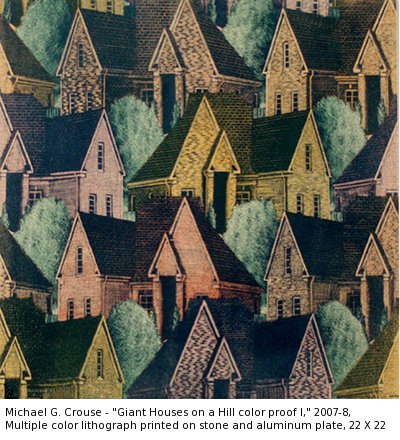The notion that the arts make our culture "richer" is commonplace in our vernacular, but an undeniable trend has emerged giving an entirely new meaning to the phrase: across the board, the country’s nonprofit arts and culture industry has grown by twenty-four percent over the past five years, generating over $166 billion in economic activity a year. Art can be big business, and not just in cosmopolitan meccas like New York and Los Angeles. Across the United States, small and midsized cities are harnessing their creative energy to jumpstart their local economies, often with striking results. Cities that have taken heed of this trend have been rewarded in multiple ways—from the rehabilitation and development of uninhabitable areas of the city to the welcoming of tourists, businesses, and well-heeled residents to those very areas. One seminal example is New York’s Soho and Tribecca neighborhoods, which now exceed the famed Upper East Side and Central Park West neighborhoods in rental and real estate prices. It is a reversal of the commonly held notion that artists drain resources, rather than attract them. Perhaps no city has been more successful in exploiting the economic potential of the arts than Paducah, Kentucky, a town of 27,000 which got the Extreme Makeover formula just right when it implemented what has come to be known as an Artist Relocation Program.
Legislation
“Over the River” and into the Legal Fray: Christo and Jeanne-Claude
Often critics comment on the technique, the style, the grandeur of a work of art, and the dramatic and arduous so-called “artistic process”. Rarely, do we study or observe how art is shaped by legal and environmental restrictions, community resistance, and bureaucratic red tape. However, unlike a painting where an artist makes choices based on subjective decisions, Christo and Jeanne-Claude’s latest planned installation Over the River appears more akin to the construction of a bridge or dam that is shaped by government agencies, public hearings, and environmental protests. By venturing outside of the museum and gallery space, and dipping their toe in the water, their latest project Over the River presents a fascinating case study on the intersection of government, the law, art and the environment that will have ramifications far past the intended two week installation.
 Continue Reading “Over the River” and into the Legal Fray: Christo and Jeanne-Claude
Continue Reading “Over the River” and into the Legal Fray: Christo and Jeanne-Claude
The Art Of Taxes: Major Changes To The Federal Transfer Tax System
Ars longs, vita brevis. Art is immortal, artists are mortal. Taxes impinge on every part of the art world and are a concern for both artists and collectors. Planning for and administering estates of artists and owners of art collections raises unique business management, income tax, transfer tax, and estate planning issues. Such planning often requires an interdisciplinary approach that addresses copyright law, tax and estate planning (including, but not limited to, charitable giving), business management, and knowledge of the valuation of a creative work. Substantial changes were made to the Federal estate, gift and generation-skipping transfer taxes by The Tax Relief, Unemployment Insurance Reauthorization, and Job Creation Act of 2010 (the "2010 Act").
Continue Reading The Art Of Taxes: Major Changes To The Federal Transfer Tax System
California AB 2765 Stops the Clock for Recovery of Wrongfully Appropriated Works: The Ramifications for Museums, Owners, Collectors and the Art Trade
For over three decades California courts and lawmakers have attempted to achieve an equitable balance between the rights of former owners and good faith purchasers of stolen works of art. In true Hollywood fashion, the thief has played his part and left the stage. Only the original owner and the good faith purchaser remain, and the legal question California has struggled with is how to allocate the risk of loss between them. In late September, 2010, California presented its latest resolution when Governor Arnold Schwarzenegger signed Assembly Bill 2765 into law, effectively doubling the time an aggrieved party can recover an object of “historical, interpretive, scientific, cultural, or artistic significance” that has been stolen or taken by fraud or duress.
Continue Reading California AB 2765 Stops the Clock for Recovery of Wrongfully Appropriated Works: The Ramifications for Museums, Owners, Collectors and the Art Trade
Fine Art Prints in California: Having the Right Paper Matters
In recent years, the production of multiples from an original work of art, especially fine art prints, has become a major business in the art world. What distinguishes a mere poster from a valuable, collectible, fine art print, is usually the scarcity and quality of the work in question. In other words, prints that are produced using high quality materials, hand signed by the artist, and sold in a limited edition are likely to be more collectible (and thus have higher resale values) than posters that are produced using low quality, inexpensive materials, unsigned by the artist, and ubiquitous.
Continue Reading Fine Art Prints in California: Having the Right Paper Matters
The European Droit de Suite – An EU Effort to Strengthen the US Contemporary Arts Market?
In 2001, the European Parliament passed Directive 2001/84/EG, which requires all EU Member States to incorporate a so called “Droit de Suite” into their respective national copyright law codes by December 31, 2009. A key goal of the Directive is to eliminate competitive barriers that existed in the contemporary and modern art market between Member States whose respective copyright laws had codified Droit de Suite decades ago (e.g.. France and Germany), and Member States whose respective copyright laws were silent on the principle (e.g. Great Britain, Austria, and the Netherlands).
Continue Reading The European Droit de Suite – An EU Effort to Strengthen the US Contemporary Arts Market?
